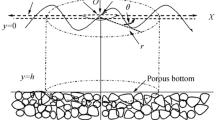Abstract
Numerical solutions of irrotational, progressive surface gravity waves in water of a constant depth are obtained by means of an iterative method. Our results suggest that waves with the surface slope angle greater thanπ/6 may exist. The calculated phase velocity of deep water waves near the wave steepness 0.14 is significantly smaller than the value given by the Stokes' fourth approximation.
In order to check our method, we apply it to the problem proposed byDavies (1951), which is hypothetical but similar to the present problem, and for which the exact solution is known. In this case our results show good agreement with the exact solution.
Similar content being viewed by others
References
Byatt-Smith, J.G.B. (1970): An exact integral equation for steady surface waves. Proc. Roy. Soc. London A,315, 405–418.
Chappelear, J.E. (1959): On the theory of highest waves. Beach Erosion Board, Tec. Mem.,116, 1–28.
Chappelear, J.E. (1961): Direct numerical calculation of wave properties. J. Geophys. Res.,66, 501–508.
Davies, T.V. (1951): The theory of symmetrical gravity waves of finite amplitude. I. Proc. Roy. Soc. London A,208, 475–486.
Fenton, J. (1972): A ninth-order solution for the solitary wave. J. Fluid Mech.,53, 257–271.
Kinsman, B. (1965): Wind waves. Prentice Hall, Englewood Cliffs, N.J.
Krasovskii, Yu P. (1961): On the theory of permanent waves of finite amplitude. Zh. Vychisl. Mat. i Mat. Fiz.,1, 836–855.
Lenau, C.W., (1966): The solitary wave of maximum amplitude. J. Fluid Mech.,26, 309–320.
Longuett-Higgins, M.S. (1963): The generation of capillary waves by steep gravity waves. J. Fluid Mech.,16, 138–156.
McCowan, J. (1894): On the highest wave of permanent type. Phil. Mag., Series 5,38, 351–358.
Michell, J.H. (1893): The highest waves in water. Phil. Mag., Series 5,36, 430–437.
Moriguchi, S., K. Udagawa, andS. Hitotsumatsu (1957): A collection of mathematical formulas. II. (in Japanese) Iwanami and Co., Hitotsubashi Tokyo.
von Schwind, J.J., andR.O. Reid (1972): Characteristics of gravity waves of permanent form. J. Geophys. Res.,77, 420–433.
Yamada, H. (1957): Highest waves of permanent type on the surface of deep water. Rep. Res. Inst. Appl. Mech. Koushu Univ.,5, 37–52.
Yamada, H. (1957): On the highest solitary wave. Rep. Res. Inst. Appl. Mech. Kyushu Univ.,5, 53–67.
Yamada, H. (1958): Permanent gravity waves on water of uniform depth. Rep. Res. Inst. Appl. Mech. Kyushu Univ.,6, 127–139.
Author information
Authors and Affiliations
Rights and permissions
About this article
Cite this article
Sasaki, K., Murakami, T. Irrotational, progressive surface gravity waves near the limiting height. Journal of the Oceanographical Society of Japan 29, 94–105 (1973). https://doi.org/10.1007/BF02109151
Received:
Published:
Issue Date:
DOI: https://doi.org/10.1007/BF02109151



